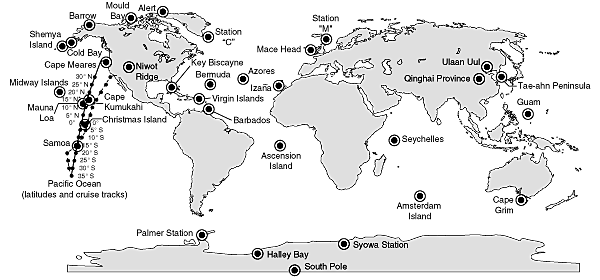
1968-92 (varies by site)
Starting in 1968, air samples were collected in cylindrical glass flasks tapered at both ends to ground glass stopcocks lubricated with hydrocarbon grease. At several sites from 1980 to 1985 samples were also collected in spherical 5-L flasks equipped with a single ground glass stopcock. These flasks were filled by the evacuation method described below. In 1983, measurements of CH4 in the flask samples were begun. Experiments at this time revealed that CO mixing ratios increased with time in the greased flasks. In 1989, 0.5-L glass flasks equipped with glass piston Teflon O-ring stopcocks were introduced into the network so CO could be measured in addition to CO2 and CH4. In 1990, measurements of 13C/12C and 18O/16O of CO2 in the flask samples were begun. The precision of the isotopic measurements was better with larger volume flasks, so in 1991 2.5-L glass flasks with two Teflon O-ring stopcocks began to replace the 0.5-L flasks. In 1994, the conversion of the network to 2.5-L flasks will be completed.
Flasks samples are always collected in pairs, once or twice per week, on a schedule determined largely by the sample collector. The sample collectors have been given guidelines concerning preferred wind speeds, directions, and time of day for sample collection. Whole air samples are collected with no attempt to remove water vapor. Samples are dried during analysis using a cryogenic trap at ¬70°C.
From 1968 to 1980, collectors used a hand-held aspirator bulb to pull
air through the flasks. In 1980, a portable battery powered pumping unit
was introduced. This method allowed the sample collector to move downwind
while the flasks, connected in series, were being flushed, enabled pressurization
of the flasks, and incorporated an intake line that could be extended to
2 m above the ground. This device resulted in improved agreement between
members of flask pairs and decreased scatter in the measurements. To avoid
artifacts due to this inhomogeneity in the data quality, most CMDL analyses
of the flask data begin with the 1981 data. The sampling method changed
again in mid-1990 when an improved portable sampler was introduced. While
the sampling principles were unchanged, the new sampler employed a single,
larger battery; a more rugged, higher capacity pump; a 5-m intake line;
and a back pressure regulator to control the pressure in the flasks. The
effect of the flask and sampler improvements has been an increase in the
percentage of sample pairs meeting a CO2
agreement criterion of 0.5 ppm, from
At Barrow, Niwot Ridge, Mauna Loa, Cape Kumukahi, Christmas Island,
and Samoa, flask samples have also been collected in evacuated 3-L flasks.
This type of flask is also used on the containerships making regular voyages
in the Pacific Ocean between Los Angeles and New Zealand. In this method
two flasks are filled in rapid succession by holding the flask into the
wind, purging the dead volume in the inlet to the flask, opening the stopcock,
and allowing the flask to fill with air to ambient atmospheric pressure.
In overlapped sampling at Mauna Loa and Niwot Ridge, no significant difference
was found between the 3-L flasks and the pressurized flasks. At Barrow
and Cape Kumukahi, there is an indication of an offset of
From 1968 until 1980, flask samples were measured by transferring the air from the flasks to a nondispersive infrared analyzer (NDIR) manually by means of a mercury displacement pump (Komhyr et al. 1983). In 1980, this apparatus was replaced by a semiautomatic analysis apparatus described by Komhyr et al. (1983). In 1988, this system was replaced by a more highly automated system that was capable of higher precision CO2 measurements and able to handle up to three times as many flasks per analysis day. All the CMDL CO2 measurements are reported in the WMO X85 mole fraction scale. The CMDL measurements are made using standard gases traceable to the WMO Central CO2 Laboratory operated by C.D. Keeling at Scripps Institution of Oceanography (Thoning et al. 1987). From 1968 to 1980, the working standard gases consisted of CO2 in N2. From 1980 to 1990, the secondary standards were CO2 in natural air and the tertiary and working gases were CO2 in synthetic air (N2, O2, and Ar) (Komhyr et al. 1985a). Since 1990, only CO2 in natural air standards have been used.
The data selection methods used to obtain the values from which monthly and annual means are calculated have been discussed in detail by Komhyr et al. (1985a), Conway et al. (1988), and Conway et al. (1994), so only a brief description will be given here. First, both members of sample pairs are flagged when the CO2 difference between them is greater than 0.5 ppm. Prior to 1989, one value of a bad pair was sometimes retained, based on the results of the curve-fitting procedure described below. Since 1989, both members of bad pairs are automatically rejected. Samples that are affected by improper sampling techniques, or analytical problems are also flagged as rejected data. At this point a curve is fit to the remaining data, and values lying more than ±3 residual standard deviations from the curve are flagged as not representing well mixed, regionally representative air masses. The curve-fitting procedure is repeated until no more samples are flagged. The fitted curves are then used to calculate monthly and annual means. Most analyses of the NOAA/CMDL flask CO2 data use only the retained data, but the samples flagged as not representative of background conditions may still contain useful information.

Sites in the NOAA/CMDL air sampling network.